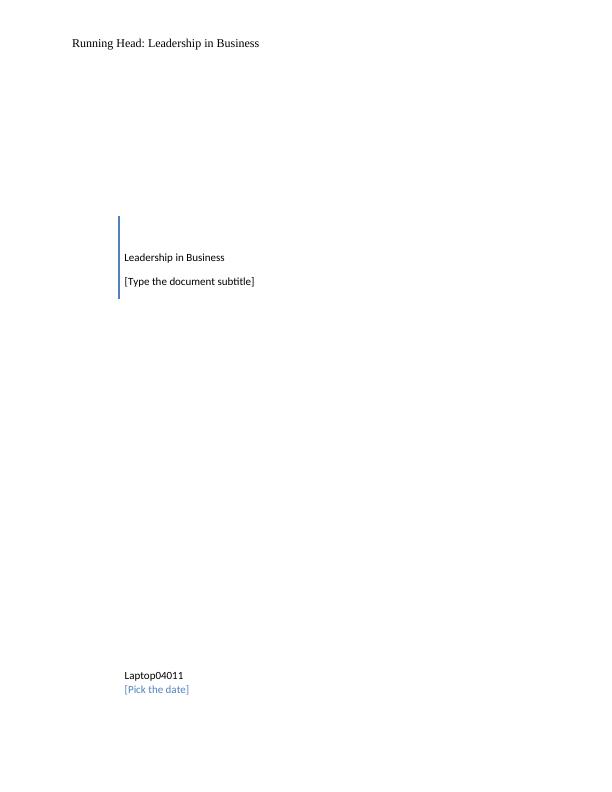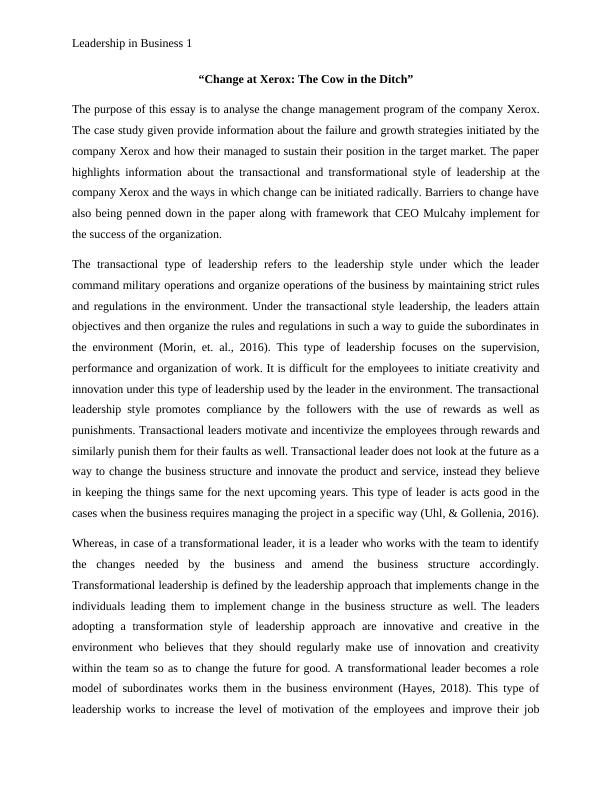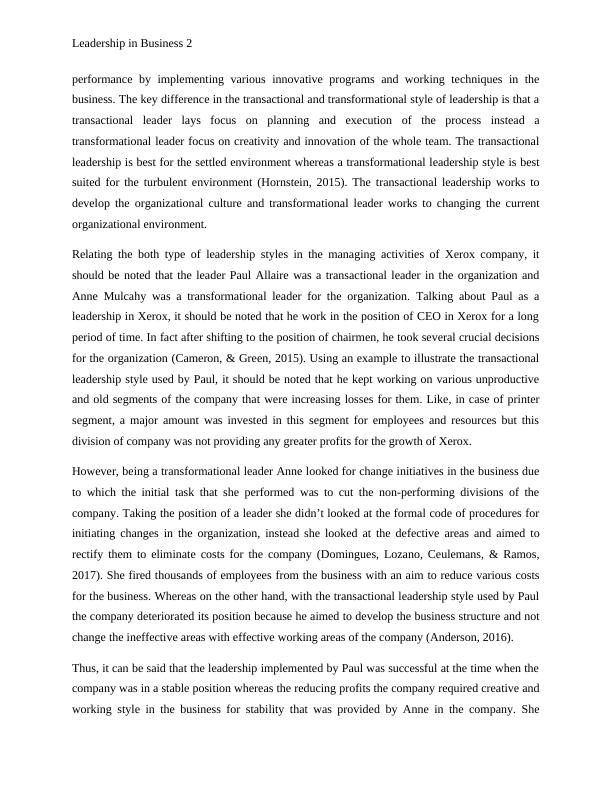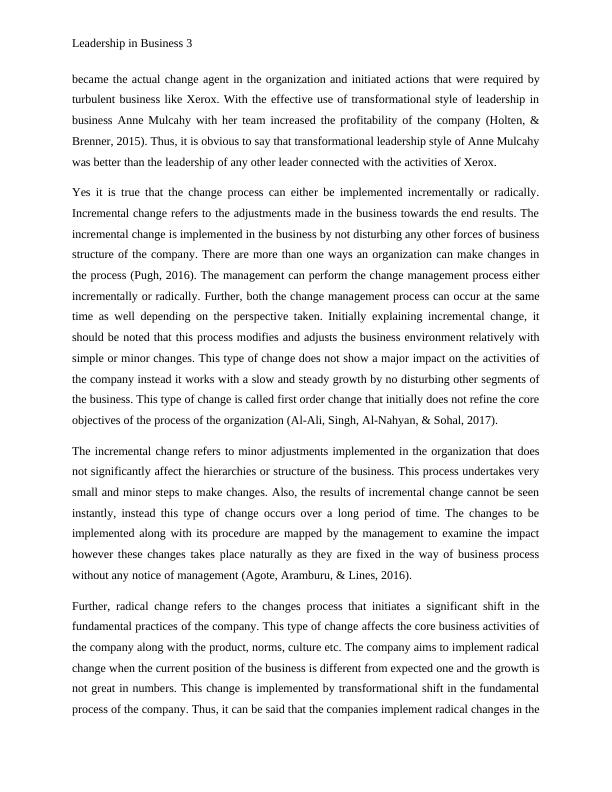Leadership in Business
Added on 2023-04-06
11 Pages3371 Words422 Views
Running Head: Leadership in Business
Leadership in Business
[Type the document subtitle]
Laptop04011
[Pick the date]
Leadership in Business
[Type the document subtitle]
Laptop04011
[Pick the date]

Leadership in Business 1
“Change at Xerox: The Cow in the Ditch”
The purpose of this essay is to analyse the change management program of the company Xerox.
The case study given provide information about the failure and growth strategies initiated by the
company Xerox and how their managed to sustain their position in the target market. The paper
highlights information about the transactional and transformational style of leadership at the
company Xerox and the ways in which change can be initiated radically. Barriers to change have
also being penned down in the paper along with framework that CEO Mulcahy implement for
the success of the organization.
The transactional type of leadership refers to the leadership style under which the leader
command military operations and organize operations of the business by maintaining strict rules
and regulations in the environment. Under the transactional style leadership, the leaders attain
objectives and then organize the rules and regulations in such a way to guide the subordinates in
the environment (Morin, et. al., 2016). This type of leadership focuses on the supervision,
performance and organization of work. It is difficult for the employees to initiate creativity and
innovation under this type of leadership used by the leader in the environment. The transactional
leadership style promotes compliance by the followers with the use of rewards as well as
punishments. Transactional leaders motivate and incentivize the employees through rewards and
similarly punish them for their faults as well. Transactional leader does not look at the future as a
way to change the business structure and innovate the product and service, instead they believe
in keeping the things same for the next upcoming years. This type of leader is acts good in the
cases when the business requires managing the project in a specific way (Uhl, & Gollenia, 2016).
Whereas, in case of a transformational leader, it is a leader who works with the team to identify
the changes needed by the business and amend the business structure accordingly.
Transformational leadership is defined by the leadership approach that implements change in the
individuals leading them to implement change in the business structure as well. The leaders
adopting a transformation style of leadership approach are innovative and creative in the
environment who believes that they should regularly make use of innovation and creativity
within the team so as to change the future for good. A transformational leader becomes a role
model of subordinates works them in the business environment (Hayes, 2018). This type of
leadership works to increase the level of motivation of the employees and improve their job
“Change at Xerox: The Cow in the Ditch”
The purpose of this essay is to analyse the change management program of the company Xerox.
The case study given provide information about the failure and growth strategies initiated by the
company Xerox and how their managed to sustain their position in the target market. The paper
highlights information about the transactional and transformational style of leadership at the
company Xerox and the ways in which change can be initiated radically. Barriers to change have
also being penned down in the paper along with framework that CEO Mulcahy implement for
the success of the organization.
The transactional type of leadership refers to the leadership style under which the leader
command military operations and organize operations of the business by maintaining strict rules
and regulations in the environment. Under the transactional style leadership, the leaders attain
objectives and then organize the rules and regulations in such a way to guide the subordinates in
the environment (Morin, et. al., 2016). This type of leadership focuses on the supervision,
performance and organization of work. It is difficult for the employees to initiate creativity and
innovation under this type of leadership used by the leader in the environment. The transactional
leadership style promotes compliance by the followers with the use of rewards as well as
punishments. Transactional leaders motivate and incentivize the employees through rewards and
similarly punish them for their faults as well. Transactional leader does not look at the future as a
way to change the business structure and innovate the product and service, instead they believe
in keeping the things same for the next upcoming years. This type of leader is acts good in the
cases when the business requires managing the project in a specific way (Uhl, & Gollenia, 2016).
Whereas, in case of a transformational leader, it is a leader who works with the team to identify
the changes needed by the business and amend the business structure accordingly.
Transformational leadership is defined by the leadership approach that implements change in the
individuals leading them to implement change in the business structure as well. The leaders
adopting a transformation style of leadership approach are innovative and creative in the
environment who believes that they should regularly make use of innovation and creativity
within the team so as to change the future for good. A transformational leader becomes a role
model of subordinates works them in the business environment (Hayes, 2018). This type of
leadership works to increase the level of motivation of the employees and improve their job

Leadership in Business 2
performance by implementing various innovative programs and working techniques in the
business. The key difference in the transactional and transformational style of leadership is that a
transactional leader lays focus on planning and execution of the process instead a
transformational leader focus on creativity and innovation of the whole team. The transactional
leadership is best for the settled environment whereas a transformational leadership style is best
suited for the turbulent environment (Hornstein, 2015). The transactional leadership works to
develop the organizational culture and transformational leader works to changing the current
organizational environment.
Relating the both type of leadership styles in the managing activities of Xerox company, it
should be noted that the leader Paul Allaire was a transactional leader in the organization and
Anne Mulcahy was a transformational leader for the organization. Talking about Paul as a
leadership in Xerox, it should be noted that he work in the position of CEO in Xerox for a long
period of time. In fact after shifting to the position of chairmen, he took several crucial decisions
for the organization (Cameron, & Green, 2015). Using an example to illustrate the transactional
leadership style used by Paul, it should be noted that he kept working on various unproductive
and old segments of the company that were increasing losses for them. Like, in case of printer
segment, a major amount was invested in this segment for employees and resources but this
division of company was not providing any greater profits for the growth of Xerox.
However, being a transformational leader Anne looked for change initiatives in the business due
to which the initial task that she performed was to cut the non-performing divisions of the
company. Taking the position of a leader she didn’t looked at the formal code of procedures for
initiating changes in the organization, instead she looked at the defective areas and aimed to
rectify them to eliminate costs for the company (Domingues, Lozano, Ceulemans, & Ramos,
2017). She fired thousands of employees from the business with an aim to reduce various costs
for the business. Whereas on the other hand, with the transactional leadership style used by Paul
the company deteriorated its position because he aimed to develop the business structure and not
change the ineffective areas with effective working areas of the company (Anderson, 2016).
Thus, it can be said that the leadership implemented by Paul was successful at the time when the
company was in a stable position whereas the reducing profits the company required creative and
working style in the business for stability that was provided by Anne in the company. She
performance by implementing various innovative programs and working techniques in the
business. The key difference in the transactional and transformational style of leadership is that a
transactional leader lays focus on planning and execution of the process instead a
transformational leader focus on creativity and innovation of the whole team. The transactional
leadership is best for the settled environment whereas a transformational leadership style is best
suited for the turbulent environment (Hornstein, 2015). The transactional leadership works to
develop the organizational culture and transformational leader works to changing the current
organizational environment.
Relating the both type of leadership styles in the managing activities of Xerox company, it
should be noted that the leader Paul Allaire was a transactional leader in the organization and
Anne Mulcahy was a transformational leader for the organization. Talking about Paul as a
leadership in Xerox, it should be noted that he work in the position of CEO in Xerox for a long
period of time. In fact after shifting to the position of chairmen, he took several crucial decisions
for the organization (Cameron, & Green, 2015). Using an example to illustrate the transactional
leadership style used by Paul, it should be noted that he kept working on various unproductive
and old segments of the company that were increasing losses for them. Like, in case of printer
segment, a major amount was invested in this segment for employees and resources but this
division of company was not providing any greater profits for the growth of Xerox.
However, being a transformational leader Anne looked for change initiatives in the business due
to which the initial task that she performed was to cut the non-performing divisions of the
company. Taking the position of a leader she didn’t looked at the formal code of procedures for
initiating changes in the organization, instead she looked at the defective areas and aimed to
rectify them to eliminate costs for the company (Domingues, Lozano, Ceulemans, & Ramos,
2017). She fired thousands of employees from the business with an aim to reduce various costs
for the business. Whereas on the other hand, with the transactional leadership style used by Paul
the company deteriorated its position because he aimed to develop the business structure and not
change the ineffective areas with effective working areas of the company (Anderson, 2016).
Thus, it can be said that the leadership implemented by Paul was successful at the time when the
company was in a stable position whereas the reducing profits the company required creative and
working style in the business for stability that was provided by Anne in the company. She

Leadership in Business 3
became the actual change agent in the organization and initiated actions that were required by
turbulent business like Xerox. With the effective use of transformational style of leadership in
business Anne Mulcahy with her team increased the profitability of the company (Holten, &
Brenner, 2015). Thus, it is obvious to say that transformational leadership style of Anne Mulcahy
was better than the leadership of any other leader connected with the activities of Xerox.
Yes it is true that the change process can either be implemented incrementally or radically.
Incremental change refers to the adjustments made in the business towards the end results. The
incremental change is implemented in the business by not disturbing any other forces of business
structure of the company. There are more than one ways an organization can make changes in
the process (Pugh, 2016). The management can perform the change management process either
incrementally or radically. Further, both the change management process can occur at the same
time as well depending on the perspective taken. Initially explaining incremental change, it
should be noted that this process modifies and adjusts the business environment relatively with
simple or minor changes. This type of change does not show a major impact on the activities of
the company instead it works with a slow and steady growth by no disturbing other segments of
the business. This type of change is called first order change that initially does not refine the core
objectives of the process of the organization (Al-Ali, Singh, Al-Nahyan, & Sohal, 2017).
The incremental change refers to minor adjustments implemented in the organization that does
not significantly affect the hierarchies or structure of the business. This process undertakes very
small and minor steps to make changes. Also, the results of incremental change cannot be seen
instantly, instead this type of change occurs over a long period of time. The changes to be
implemented along with its procedure are mapped by the management to examine the impact
however these changes takes place naturally as they are fixed in the way of business process
without any notice of management (Agote, Aramburu, & Lines, 2016).
Further, radical change refers to the changes process that initiates a significant shift in the
fundamental practices of the company. This type of change affects the core business activities of
the company along with the product, norms, culture etc. The company aims to implement radical
change when the current position of the business is different from expected one and the growth is
not great in numbers. This change is implemented by transformational shift in the fundamental
process of the company. Thus, it can be said that the companies implement radical changes in the
became the actual change agent in the organization and initiated actions that were required by
turbulent business like Xerox. With the effective use of transformational style of leadership in
business Anne Mulcahy with her team increased the profitability of the company (Holten, &
Brenner, 2015). Thus, it is obvious to say that transformational leadership style of Anne Mulcahy
was better than the leadership of any other leader connected with the activities of Xerox.
Yes it is true that the change process can either be implemented incrementally or radically.
Incremental change refers to the adjustments made in the business towards the end results. The
incremental change is implemented in the business by not disturbing any other forces of business
structure of the company. There are more than one ways an organization can make changes in
the process (Pugh, 2016). The management can perform the change management process either
incrementally or radically. Further, both the change management process can occur at the same
time as well depending on the perspective taken. Initially explaining incremental change, it
should be noted that this process modifies and adjusts the business environment relatively with
simple or minor changes. This type of change does not show a major impact on the activities of
the company instead it works with a slow and steady growth by no disturbing other segments of
the business. This type of change is called first order change that initially does not refine the core
objectives of the process of the organization (Al-Ali, Singh, Al-Nahyan, & Sohal, 2017).
The incremental change refers to minor adjustments implemented in the organization that does
not significantly affect the hierarchies or structure of the business. This process undertakes very
small and minor steps to make changes. Also, the results of incremental change cannot be seen
instantly, instead this type of change occurs over a long period of time. The changes to be
implemented along with its procedure are mapped by the management to examine the impact
however these changes takes place naturally as they are fixed in the way of business process
without any notice of management (Agote, Aramburu, & Lines, 2016).
Further, radical change refers to the changes process that initiates a significant shift in the
fundamental practices of the company. This type of change affects the core business activities of
the company along with the product, norms, culture etc. The company aims to implement radical
change when the current position of the business is different from expected one and the growth is
not great in numbers. This change is implemented by transformational shift in the fundamental
process of the company. Thus, it can be said that the companies implement radical changes in the

End of preview
Want to access all the pages? Upload your documents or become a member.
Related Documents
Leadership Styles in National Bank of Bahrain: A Comparison of Transactional and Transformational Leadershiplg...
|24
|3442
|391
Leadership Styles and Change Implementation at Xeroxlg...
|12
|3252
|475
Transformational vs Transactional Leadership in Fast Food Restaurantlg...
|20
|1343
|134
Leadership in a Changing context PDFlg...
|24
|3641
|25
Jack Welch: Leadership Style and Change Managementlg...
|7
|1590
|481
Transactional and Transformational Leadership and Their Impact on Workforce Behaviorlg...
|8
|2159
|165
